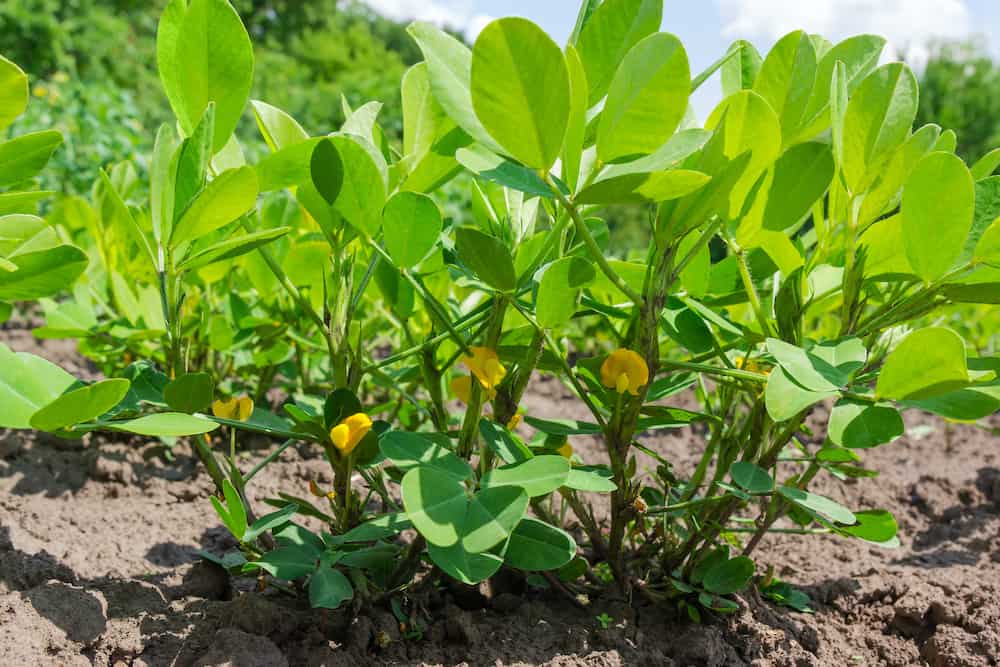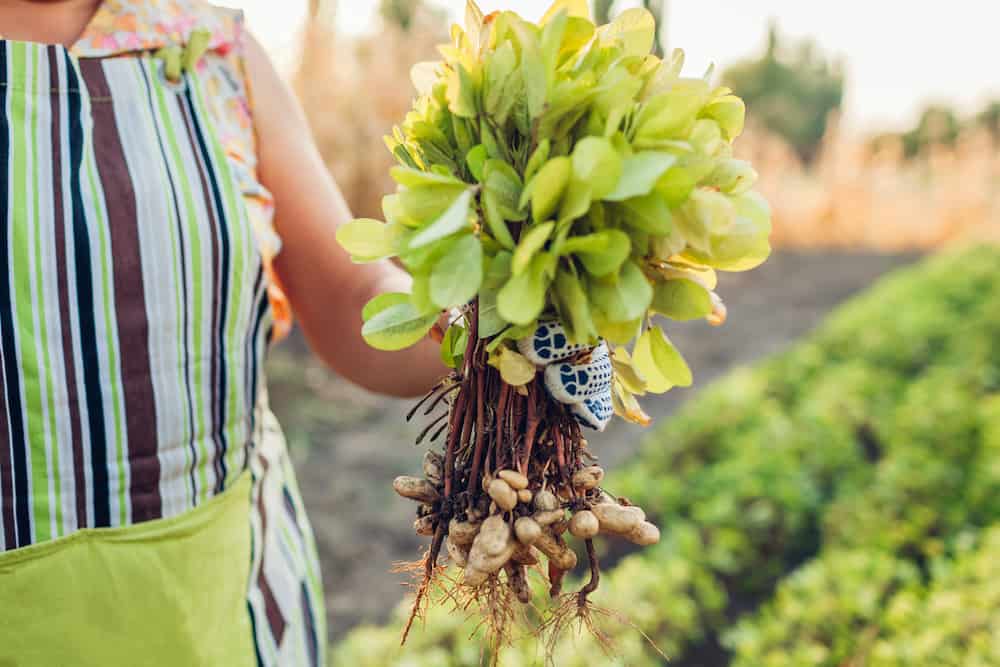Many plants can provide you with food, but one of the most interesting is the peanut plant or Arachis hypogaea. Arachis means that the plant’s pods grow underground, while hypogaea means underground crypt.
From its botanical name, you can already tell that peanuts grow underneath the soil in their own little space, so they’re also known as groundnuts.
Peanuts are believed to have originated in South America. Peruvian Indians were cultivating them approximately 3,500 years ago. Today, a lot of people are growing peanuts in their own backyards, so let’s learn how they grow and how to grow them.
How Do Peanuts Grow?
Similar to any other plants, when you plant peanuts, it will undergo several stages, such as:
1. Seed Cracking
The peanut seeds will start growing and rising from the soil about 10 days after you plant them.
At this stage, your plant is green and oval-leafed and is roughly 18 inches tall. The flowers come up above the ground while the fruit stays below.
2. Flowering
During this stage, you will see yellow flowers along the lower part of the peanut plants, but it can take 40 days to see results. The flowers can pollinate themselves. As the petals fall off, the ovary of the nut starts to form.
3. Pegging
The ovary bud is called the peg. It enlarges, and then starts growing away and down from the plant. You would see a small stem going into the soil at this time. This embryo is at the tip and goes into the soil.
Then, it ends up going horizontal to the surface and takes the form of a more mature peanut. It continues to flower and grow and is likely to produce over 40 pods.
Peanut Planting Guide
Farmers often plant peanut kernels that were specially treated and grown from last year’s crop, which you can also do. That said, you can also purchase seeds, which are actually fresh, uncooked, raw peanuts that are still in their shell.
Usually, it’s good to choose a variety of peanuts that matures faster, such as the Early Spanish peanut.
What You Need
To be successful growing peanuts, the most important thing is to live in the proper growing zone for peanuts. The USDA hardiness zone for peanut plants is 8 – 12. This is where peanuts grow best. Certain varieties do better if you live outside these zones, but they may be more difficult to grow.
When planting peanuts, you need plenty of space for the pegging process.
That is also because they grow two inches deep to the ground, about one or two inches apart. At times, they also grow in rows.
Therefore, if you don’t plant peanuts in a garden bed or field, you need planters, pots, or recycled containers that are 12 inches deep and 18 inches wide for one peanut plant.
You also need fertilizer and nitrogen-rich soil.
If you have the space, companion plants for peanut plants include cilantro, radishes, and lettuce seeds.
When to Plant
Generally, you should wait until a few weeks past the last frost in spring before planting peanuts. In North America, that is around April or May. The soil temperature should be a minimum of 65 degrees at a depth of 4 inches.
However, you can get a head start on the planting by sowing them indoors about five to eight weeks before you plan to transplant them outside.
Also, although you’re supposed to wait until the last of the frosts, they can be unpredictable.
Therefore, even if you plant peanuts during the recommended time, consider plastic row covers or small tarps that can go over your young plants to protect them from possible frosts.
Where to Plant
Consider a south-facing slope for the peanuts to get more sunlight each day.
If you live in colder climates, you can use dark-colored containers to keep the roots warm.
How to Plant Peanuts
If you want to plant peanuts in a container, you must use self-draining planters with the specifications mentioned earlier.
Fill the planters 2/3 to 3/4 full with pre-moistened potting soil to give the roots enough room to grow. Dig a hole where you can place the peanuts and then cover them completely with soil.
When planting in your garden bed or field, make sure that each peanut seed (shell) is two inches deep into the ground and eight inches apart.
You should also make sure that the soil has been well-drained and tilled. You may need to add aged compost and sand to it.
If you plan to grow radishes, cilantro, or lettuce together with the peanut, plant them along the container’s outer wall.
Remove the other plants when the peanut plant is about six inches high.

How to Care for Peanut Plants
After you’ve planted the seeds successfully, you have to make sure they grow healthily by doing the following:
1. Nourish Them
Add some fertilizer to the soil so that there are plenty of nutrients. Organic fertilizer is ideal.
Remember, peanuts are nitrogen-fixing plants. The roots form modules to absorb the air’s nitrogen and give the soil and plant nutrition and enrichment.
Thus, you need more nitrogen than potassium or phosphorus, though you can use any NPK ratio with high nitrogen levels.
Follow the directions on the package but fertilize immediately and then every few weeks as indicated on the instructions.
2. Till the Soil
When you apply fertilizer, it is also the best time to cultivate around the plant to help loosen the soil. That way, the pegs penetrate more easily.
3. Water Them Regularly
You must water the plant every week while the kernel is developing. Generally, these plants require about 1.5 to 2 inches of water per week. Try not to water the leaves when you water the peanut plants.
Rain often meets those needs, but if that doesn’t happen, you must water it yourself. If you don’t, the peanut is likely to show stress from drought.
The most important time for watering is between 60 – 110 days. This is the time the pegs enter the soil and the pods start to develop.
How to Harvest Peanuts
Once your plant has fully matured, the peanuts will be ready for harvesting. You will know when peanuts are ready to harvest because the leaves will turn yellow and start to wilt and droop. Peanuts mature 120 – 150 days from planting. Therefore, if you plant them in April, this means you will harvest them in September or October.
Because peanuts grow underground, it’s difficult to know when they are ready to pick. It’s similar to when you grow carrots or grow potatoes. You really won’t know how mature they are until you see or feel them.
We recommend you pick several by hand by gently reaching into the soil. Pull off a few peanuts. After you pick a few, and they don’t seem fully mature, you should wait a few more days before harvesting.
When you harvest peanuts, you uproot the entire peanut plant. Here’s how to harvest peanuts:
1. Digging
When harvesting your peanuts, you should ensure that the soil isn’t too dry or wet before you start digging.
If you’ve planted them in rows in the garden, you would need a digger to run up and down the rows. This equipment has multiple long blades that can go from four to six inches underneath the ground to loosen the plant and sever the taproot.
Otherwise, you may be able to pull the plants out by hand.
2. Lifting and Shaking
Using your hands or a shaker, lift the plant from the soil, and then gently shake it to remove the soil and other debris from the peanuts.
If you planted them in a pot or container, pull out the entire plant as well.
3. Drying
When you first dig up the peanuts, they will contain up to 50% moisture. You must dry them up so that there is 10% or less moisture before storing them.
Air dry the peanuts by hanging them in an area that is warm and dry. You can hang them inside your home or in a shed, garage, etc. The important things are the area has low humidity and is warm. Hang them for 14 days to cure.
Be sure to put them in a safe area, away from critters.
4. Combining
Once the peanuts are dry, separate the vines from the nuts. Gently remove the peanuts and place them on a tray to dry them further. Crack one or two open to check the consistency. You may need to air dry them for another week.
Continue drying them until they reach 10 percent moisture and store them in airtight containers for safekeeping. Choose glass containers if possible.
Peanut Plant Varieties
Depending on where you live, certain varieties may do better per your hardiness zone. There are four basic types.
- Runner: Grow well in the south. Runner is the peanut most commonly grown in the US.
- Spanish: This type grows well in Texas and Oklahoma.
- Valencia: These grow well in New Mexico.
- Virginia: Grow well in North Carolina, South Carolina and in Virginia
Peanut FAQs
1. How Long Do Peanuts Take to Grow?
A good crop needs between 120 and 150 days without frost or about four to five months from the time you plant until harvesting. However, this depends on the variety and type of peanut seed that you used.
2. Where Do Peanuts Grow Best?
Usually, peanuts grow well in warm climates, but people can grow them as far north as Canada in a greenhouse or warm parts of the home. The ideal growing zone for peanuts is 8 – 12.
3. Are Peanuts Easy to Grow?
Yes, because they don’t require a lot of care and give you enough of a yield to last the whole year. One of the best things about growing peanuts and something that makes gardeners successful is peanut plants self-pollinate.
This means that for them to produce peanuts, they don’t need bees, flies, other insects or other peanut plants to pollinate. This makes growing peanuts in areas where there are scarce pollinators attractive.
4. Can I Grow a Peanut Plant Indoors?
Yes, you can plant peanuts indoors and then transplant them after or place them in the area of your home where they can get enough sunlight.
To do so, get a four-inch-deep bowl and fill it 2/3 to 3/4 full with pre-moistened potting soil.
Dig a hole where you can place the peanut, and then you can transplant them outside when the frosts have gone.
5. Can I Grow Peanuts in a Garden Bed?
Yes, you can grow peanuts in a garden bed or right in the ground. You can also grow peanuts in deep containers or pots.
6. How Many Peanuts Grow Per Plant?
In ideal conditions, each peanut plant should yield between 40 – 50 pods.
Benefits of Planting Peanuts
Peanuts are a nutritious type of food because they contain a lot of protein, few carbohydrates, and no cholesterol.
How do peanuts grow and how to plant peanuts are simple processes, though they have a longer growing season than other legumes.
Peanuts are hardy. They have basic needs such as water, sunlight, and fertilizer. One of the best things about planting peanuts is they don’t need a pollinator source such as bees or wind. They are self-pollinating.
In addition, peanuts are easy to store. They make a sustainable food source.

